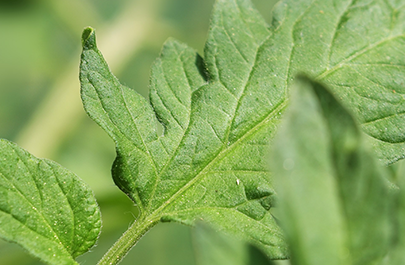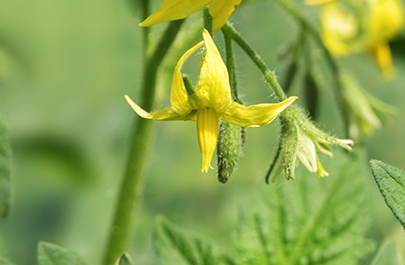






(Unit/t of production)
(Unit/t of production)
N
2.7
2.7
Very Sensitive
P2O5
0.9
0.9
Very Sensitive
K2O
6.2
6.2
Very Sensitive
CaO
2.5
2.5
Very Sensitive
MgO
0.8
0.8
Sensitive
SO3
0.5
0.5
Sensitive
TE
Zinc, iron, boron and manganese
Fertilizing tomatoes correctly depends on several factors:
Under suitable conditions, high-yielding tomato varieties are expected to produce 100-150 tonnes per hectare. Determinate tomato varieties need fertilization to support sustained growth and at the same time the ripening of fruit with high market value.
The nitrogen supply must be sufficient for as long as growth continues. However, an excess supply of nitrogen can affect fruit quality and delay ripening. At this stage, ammonium (NH4+) is the preferred nitrogen form. Appropriate phosphorus and potassium levels ensure high quality (taste, colour, firmness and shelf-life). Ensuring the necessary potassium level is important for fruit formation and fruit enlargement. Calcium deficiency induces blight, often as a result of unfavourable summer climates. The optimum pH value of the soil is between 6.5 and 7. Tomatoes are not only sensitive to salt, but also to zinc, iron, boron and manganese deficiencies. Sulphur fertilizer in particular improves the firmness and colour of the fruit. Dose splitting is necessary. The amount of calcium necessary for the tomatoes is applied prior to planting in autumn.
Fertigation facilitates the adaption of fertilizer composition and quantity to different growth phases.
Yield parameters of tomatoes:
The amount of shoots per m² and a continuous production of flowers and fruit determine the yield. For this, especially at the beginning, nitrogen and magnesium supply is important. For well-developed tomatoes with a healthy and strong colour and classic taste, it is important to have sufficient potassium, no oversupply of calcium, and sufficient sulphur and water.
First application

Second application

Third application

Moderate fertilization from planting until the first flowering:
Tomatoes need relatively little fertilizer at the beginning of their growth. In order to develop a good root system, the supply of nutrients and water is kept to a minimum in the first few weeks. Therefore, only about 1/7 of the amount of nitrogen and phosphorus are allocated to the first batch of fruit. Only 1/13 of the total potassium requirement is given at this stage. The best solution for this administration is a chloride-free NPK fertilizer with emphasis on nitrogen and potash (COMPLEX 15/5/18 + 2.5MgO+25SO3+B+Zn).
First flowering phase until the beginning of harvest; increasing demand for balanced fertilization.
In this phase, the fruit formation of the tomato, and at the same time, continuous growth and flowering, should be promoted. Therefore, particularly balanced nutrient ratios are necessary. Too much nitrate at this stage is particularly precarious, so ammonium fertilizers are preferred. Magnesium supply also needs to be taken into account at this stage. The same NPK formula is used in this fertilization phase, but the application rate is about three times higher than in the first fertilizer application.
Start of harvest until end of crop; full amounts of potassium fertilizer.
This is the main fertilization phase for tomatoes. Deficiencies are shown not only by poorly-formed fruits and lack of taste, but also by lower flower bud formation and subsequently low total yield. The potassium requirement ranges up to 500 kg/ha. A continuous dosage of nutrients via a suitable L.A.T product ensures supply. Fertilization can be stopped about two weeks prior to the end of the harvest. Then the nutrients that are still present in the plants will be sufficient until the ripening of the last fruits.
LAT Nitrogen Austria GmbH
St.-Peter-Strasse 25
4021 Linz, Austria











